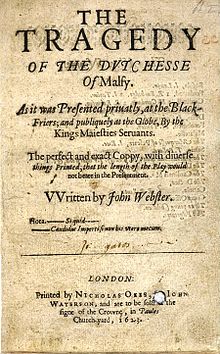User:Farrar80/sandbox
 | This is a user sandbox of Farrar80. A user sandbox is a subpage of the user's user page. It serves as a testing spot and page development space for the user and is not an encyclopedia article. |
 | This is a user sandbox of Farrar80. A user sandbox is a subpage of the user's user page. It serves as a testing spot and page development space for the user and is not an encyclopedia article. |
The revenge tragedy (sometimes referred to as revenge drama, revenge play, or tragedy of blood) defines a genre of plays made popular in early modern England. Ashley H. Thorndike introduced this genre in his seminal 1902 article "The Relations of Hamlet to Contemporary Revenge Plays," which characterizes revenge tragedy "as a tragedy whose leading motive is revenge and whose main action deals with the progress of this revenge, leading to the death of the murderers and often the death of the avenger himself."[1] Thomas Kyd's The Spanish Tragedy (c.1580s) is often considered the inaugural revenge tragedy on the early modern stage. However, more recent research extends early modern revenge tragedy to the 1560s with poet and classicist Jasper Heywood's translations of Seneca at Oxford University, including Troas (1559), Thyestes (1560), and Hercules Furens (1561).[2] Additionally, Thomases Norton and Sackville's play Gorbuduc (1561) is considered an early revenge tragedy (almost twenty years prior to The Spanish Tragedy). Other well-known revenge tragedies include William Shakespeare's Hamlet (c.1599-1602) and Titus Andronicus (c.1588-1593) and Thomas Middleton's The Revenger's Tragedy (c.1606).
Revenge tragedy as a genre
[edit]The genre of revenge tragedy is a modern generic invention, developed as a means to talk about early modern tragedies that maintain a theme or motif of revenge in varying degrees. In respect to early modern drama more broadly, generic classification is difficult and, at times, contentious, and revenge tragedy is by no means exempt from this. Lawrence Danson, for example, suggests that Shakespeare and his contemporaries had a "healthy ability to live comfortably with the unruliness of a theatre where genre was not static but moving and mixing, always producing new possibilities.[3] Shakespeare's 1623 First Folio's frontispiece famously depicts the three genres of comedy, tragedy, and history, but scholars have devised additional genres, including not only revenge tragedy but also city comedy, romance, pastoral, and problem plays, among others, in order to accommodate the generic slipperiness of early modern drama.
While Thorndike is rather conservative in his definition of a revenge tragedy, it has become common to consider any tragedy that maintains an element of revenge in it a revenge tragedy.[citation needed] Lily Campbell even argues that revenge is the great thematic uniter of all early modern tragedy, and "all Elizabethan tragedy must appear as fundamentally a tragedy of revenge if the extent of the idea of revenge be but grasped.[4]

Furthermore, Fredson Bowers's groundbreaking work (1959) on this genre significantly widened and complicated not only what revenge tragedy is but also augmented its function as a productive lens in the work of dramatic and dramaturgical interpretation.[citation needed] A revenge tragedy thus can also be any tragedy where revenge is, more or less, a minor part of the overall narrative rather than just a narrative's major driving force. For example, John Webster's The Duchess of Malfi (c.1613), while often classified as a tragedy (its original frontispiece marketed it as The Tragedy of the Dutchesse of Malfy), it can also be classified or read as a revenge tragedy since both major and minor characters are motivated by revenge. Likewise, Titus Andronicus was originally marketed in the First Folio as The Lamentable Tragedy of Titus Andronicus, and Hamlet was similarly titled in the First Folio as The Tragedie of Hamlet, Prince of Denmarke and The Tragicall Historie of Hamlet, Prince of Denmarke in the Second Quarto edition (1604).
Generic conventions
[edit]While these conventions don't apply to all plays that can be read as revenge tragedies, this list represents those things that typically take place in the narrative of a revenge tragedy.
- The revengers are always killed
- Spectacle for the sake of spectacle
- Tool villains and accomplices that assist the revenger are killed
- The supernatural (often in the form of a ghost who urges the protagonist to enact vengeance)
- A play within a play and/or dumb show
- Madness or feigned madness
- Disguise
- Violent murders, including decapitation and dismemberment
- Soliloquies
- A Machiavel figure
- Cannibalism (Thyestean banquets)
- A fifth and final act where many characters are killed (multiple corpses on the stage)
- Degeneration of a once-noble protagonist
- In later Jacobean and Caroline revenge tragedies, the protagonist is more often a villain than a hero (though this is highly subjective)
- In later revenge tragedies, there is often more than one character seeking revenge
References
[edit]- ^ Thorndike, A. H. "The Relations of Hamlet to Contemporary Revenge Plays." Modern Language Association. 17.2 (1902): 125-220. Print.
- ^ Irish, Bradley J. "Vengeance, Variously: Revenge before Kyd in Early Elizabethan Drama." Early Theatre. 12.2 (2009): 117-134. Print.
- ^ Danson, Lawrence. Shakespeare's Dramatic Genres. Oxford University Press, Oxford: 2000. Print. p. 11.
- ^ Campbell, Lily. "Theories of Revenge in Renaissance England." Modern Philology. 28.3 (1931) 281-296. Print.
